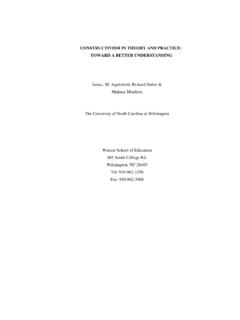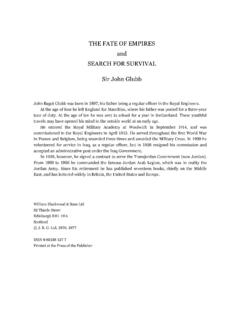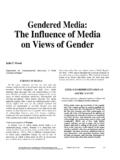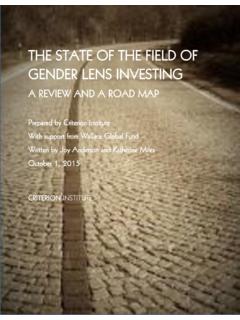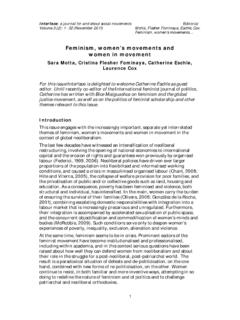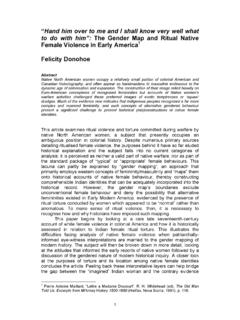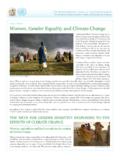Transcription of What It Means to Be Gendered Me: Life on the …
1 What It Means to Be Gendered Me: life on the Boundaries of a Dichotomous Gender SystemAuthor(s): Betsy LucalSource: Gender and Society, Vol. 13, No. 6 (Dec., 1999), pp. 781-797 Published by: Sage Publications, URL: : 07/04/2009 13:21 Your use of the JSTOR archive indicates your acceptance of JSTOR's Terms and Conditions of Use, available JSTOR's Terms and Conditions of Use provides, in part, that unlessyou have obtained prior permission, you may not download an entire issue of a journal or multiple copies of articles, and youmay use content in the JSTOR archive only for your personal, non-commercial contact the publisher regarding any further use of this work. Publisher contact information may be obtained copy of any part of a JSTOR transmission must contain the same copyright notice that appears on the screen or printedpage of such is a not-for-profit organization founded in 1995 to build trusted digital archives for scholarship. We work with thescholarly community to preserve their work and the materials they rely upon, and to build a common research platform thatpromotes the discovery and use of these resources.
2 For more information about JSTOR, please contact Publications, Inc. is collaborating with JSTOR to digitize, preserve and extend access to Gender WHAT IT Means TO BE Gendered ME life on the Boundaries of a Dichotomous Gender System BETSY LUCAL Indiana University South Bend What are the implications of living in a gender system that recognizes "two and only two " genders? For those individuals whose "gender displays" are inappropriate, there can be a variety of consequences, many of them negative. In this article, the author provides an analysis of her experiences as a woman whose appearance often leads to gender misattribution. She discusses the consequences of the gender system for her identity and her interactions. The author also examines Lorber's assertion that "gender bending " actually serves to perpetuate gender categories rather than to break them down, and she sug- gests how her experiences might contradict Lorber's argument. Using her biography to examine the social construction of gender, she both illustrates and extends theoretical work in this area.
3 I understood the concept of "doing gender" (West and Zimmerman 1987) long before I became a sociologist. I have been living with the consequences of inappro- priate "gender display" (Goffman 1976; West and Zimmerman 1987) for as long as I can remember. My daily experiences are a testament to the rigidity of gender in our society, to the real implications of "two and only two" when it comes to sex and gender catego- ries (Garfinkel 1967; Kessler and McKenna 1978). Each day, I experience the con- sequences that our gender system has for my identity and interactions. I am a woman who has been called "Sir" so many times that I no longer even hesitate to assume that it is being directed at me. I am a woman whose use of public rest rooms regularly causes reactions ranging from confused stares to confrontations over what a man is doing in the women's room. I regularly enact a variety of practices AUTHOR'S NOTE: I thank the journal's reviewers, my writing group (Linda Chen, Louise Collins, April Lidinsky, Margarete Myers, Monica Tetzlaff, and Becky Torstrick), Heather Bulan, and Linda Fritschner for their helpful comments on earlier versions of this article.
4 REPRINT REQUESTS: Betsy Lucal, Department of Sociology, Indiana University South Bend, Box 7111, South Bend, IN46634-7111; e-mail: GENDER & SOCIETY, Vol. 13 No. 6, December 1999 781-797 ? 1999 Sociologists for Women in Society 781 782 GENDER & SOCIETY / December 1999 either to minimize the need for others to know my gender or to deal with their misattributions. I am the embodiment of Lorber's (1994) ostensibly paradoxical assertion that the "gender bending" I engage in actually might serve to preserve and perpetuate gender categories. As a feminist who sees gender rebellion as a significant part of her contribution to the dismantling of sexism, I find this possibility disheartening. In this article, I examine how my experiences both support and contradict Lor- ber's (1994) argument using my own experiences to illustrate and reflect on the social construction of gender. My analysis offers a discussion of the consequences of gender for people who do not follow the rules as well as an examination of the possible implications of the existence of people like me for the gender system itself.
5 Ultimately, I show how life on the boundaries of gender affects me and how my life , and the lives of others who make similar decisions about their participation in the gender system, has the potential to subvert gender. Because this article analyzes my experiences as a woman who often is mistaken for a man, my focus is on the social construction of gender for women. My assump- tion is that, given the Gendered nature of the gendering process itself, men's experi- ences of this phenomenon might well be different from women's. THE SOCIAL CONSTRUCTION OF GENDER It is now widely accepted that gender is a social construction, that sex and gender are distinct, and that gender is something all of us "do." This conceptualization of gendercan be traced to Garfinkel's (1967) ethnomethodological study of"Agnes."1 In this analysis, Garfinkel examined the issues facing a male who wished to pass as, and eventually become, a woman. Unlike individuals who perform gender in cul- turally expected ways, Agnes could not take her gender for granted and always was in danger of failing to pass as a woman (Zimmerman 1992).
6 This approach was extended by Kessler and McKenna (1978) and codified in the classic "Doing Gender" by West and Zimmerman (1987). The social construction- ist approach has been developed most notably by Lorber (1994, 1996). Similar theoretical strains have developed outside of sociology, such as work by Butler (1990) and Weston (1996). Taken as a whole, this work provides a number of insights into the social processes of gender, showing how gender(ing) is, in fact, a process. We apply gender labels for a variety of reasons; for example, an individual's gender cues our interactions with her or him. Successful social relations require all participants to present, monitor, and interpret gender displays (Martin 1998; West and Zimmerman 1987). We have, according to Lorber, "no social place for a person who is neither woman nor man" (1994,96); that is, we do not know how to interact with such a person. There is, for example, no way of addressing such a person that does not rely on making an assumption about the person's gender ("Sir" or "Ma'am").
7 In this context, gender is "omnirelevant" (West and Zimmerman 1987). Lucal / life ON THE BOUNDARIES 783 Also, given the sometimes fractious nature of interactions between men and women, it might be particularly important for women to know the gender of the strangers they encounter; do the women need to be wary, or can they relax (Devor 1989)? According to Kessler and McKenna (1978), each time we encounter a new per- son, we make a gender attribution. In most cases, this is not difficult. We learn how to read people's genders by learning which traits culturally signify each gender and by learning rules that enable us to classify individuals with a wide range of gender presentations into two and only two gender categories. As Weston observed, "Gen- dered traits are called attributes for a reason: People attribute traits to others. No one possesses them. Traits are the product of evaluation" (1996, 21). The fact that most people use the same traits and rules in presenting genders makes it easier for us to attribute genders to them.
8 We also assume that we can place each individual into one of two mutually exclusive categories in this binary system. As Bem (1993) notes, we have a polar- ized view of gender; there are two groups that are seen as polar opposites. Although there is "no rule for deciding 'male' or 'female' that will always work" and no attrib- utes "that always and without exception are true of only one gender" (Kessler and McKenna 1978, 158, 1), we operate under the assumption that there are such rules and attributes. Kessler and McKenna's analysis revealed that the fundamental schema for gen- der attribution is to "See someone as female only when you cannot see [the person] as male" (1978, 158). Individuals basically are assumed to be male/men until proven otherwise, that is, until some obvious marker of conventional femininity is noted. In other words, the default reading of a nonfeminine person is that she or he is male; people who do not deliberately mark themselves as feminine are taken to be men.
9 Devor attributed this tendency to the operation of gender in a patriarchal con- text: "Women must mark themselves as 'other'," whereas on the other hand, "few cues [are required] to identify maleness" (1989, 152). As with language, masculine forms are taken as the generically human; femininity requires that something be added. Femininity "must constantly reassure its audience by a willing demonstra- tion of difference" (Brownmiller 1984, 15). Patriarchal constructs of gender also devalue the marked category. Devor (1989) found that the women she calls "gender blenders" assumed that femininity was less desirable than masculinity; their gender blending sometimes was a product of their shame about being women. This assumption affects not only our perceptions of other people but also individuals' senses of their own Gendered selves. Not only do we rely on our social skills in attributing genders to others, but we also use our skills to present our own genders to them.
10 The roots of this understand- ing of how gender operates lie in Goffman's (1959) analysis of the "presentation of self in everyday life ," elaborated later in his work on "gender display" (Goffman 1976). From this perspective, gender is a performance, "a stylized repetition of acts" (Butler 1990, 140, emphasis removed). Gender display refers to "convention- alized portrayals" of social correlates of gender (Goffman 1976). These displays 784 GENDER & SOCIETY / December 1999 are culturally established sets of behaviors, appearances, mannerisms, and other cues that we have learned to associate with members of a particular gender. In determining the gender of each person we encounter and in presenting our genders to others, we rely extensively on these gender displays. Our bodies and their adornments provide us with "texts" for reading a person's gender (Bordo 1993). As Lorber noted, "Without the deliberate use of Gendered clothing, hair- styles, jewelry, and cosmetics, women and men would look far more alike" (1994, 18-19).
